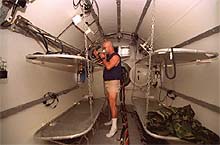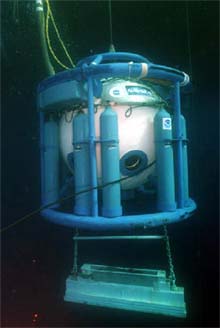
Divers lived in this chamber for 2 wks at a time saturated with a gas mixture of 85 percent helium and 15 percent oxygen. This allowed the divers to work in 8-hr shifts on the USS Monitor site, 240 ft below the ocean surface. Official U.S. Navy photo by Photographer's Mate Second Class Petty Officer (DV) Eric Lippmann. Click image for larger view.

The SAT system diving bell is raised to the surface after an 8-hr dive on the wreck of the USS Monitor. The bell is the divers' "taxi" between their topside saturation living quarters and their work site, some 240 ft below the surface. Official U.S. Navy photo by Photographer’s Mate Chief Petty Officer (DV/SW) Andrew McKaskle. Click image for larger view.
The Navy’s Use of Saturation Diving on the USS Monitor
July 30, 2001
Captain Christopher Murray, U.S. Navy
Supervisor of Diving
In planning the Monitor 2001 Expedition, the U.S. Navy saw a golden opportunity to prove a diving system concept that would benefit the work on the USS Monitor and, at the same time, increase its own diving and underwater recovery capability. The Office of the Supervisor of Salvage and Diving ![]() , Naval Sea Systems Command, led an effort to identify, evaluate and then obtain an OPNAV (Navy) waiver so that Navy divers could use a civilian saturation (SAT) diving system during the Monitor expedition. The system identified and used during this 2001 field season was the Global Industries' 1504 system. This two-chamber, 1500-ft system has a two-person diving bell.
, Naval Sea Systems Command, led an effort to identify, evaluate and then obtain an OPNAV (Navy) waiver so that Navy divers could use a civilian saturation (SAT) diving system during the Monitor expedition. The system identified and used during this 2001 field season was the Global Industries' 1504 system. This two-chamber, 1500-ft system has a two-person diving bell.
The chamber was loaded aboard the derrick barge Wotan in Homa, LA, in late May. A team of 20 Navy saturation divers from various Navy commands, together with the Supervisor of Diving, assisted with the onload and then began an extensive testing, evaluation, and training period. By the time the barge arrived at the Monitor Sanctuary on June 17, the Navy team was ready to complete an internal pressure test to depth (240 ft) on the bell and then conduct an evaluated operational dive to depth on the Monitor. Once these tests were successfully completed, the system was given the waiver for use during the expedition.
From June 17 through July 25, Navy divers completed 465 hrs of working bottom time on the USS Monitor. Out of the total of 666 total hrs of bottom time, including the surface-supplied mixed-gas (helium-oxygen) diving that was completed during the mission, the SAT system accounted for 70% of all bottom time. The proof-of-concept of Navy divers utilizing a civilian SAT system was a complete success. During the mission, the saturation system was able to dive for all but 48 hrs, time that was lost due to heavy seas or high currents. This is incredible when one thinks of the unpredictable sea conditions frequently encountered off of Cape Hatteras. The Navy divers were able to work at intervals of up to 5 hrs at a time during a single excursion (time outside the diving bell). This time allowed the divers to complete more complex tasks, and also enabled NOAA archeologists to work more closely, and more slowly, with the divers when they were excavating items such as the turret.
With the proof-of-concept a resounding success, the next step is to move forward with recommendations for future SAT operations, which will include work on the USS Monitor in 2002.
Sign up for the Ocean Explorer E-mail Update List.






















